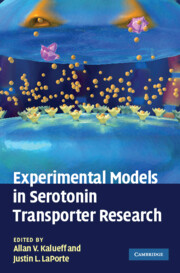Book contents
- Frontmatter
- Contents
- List of contributors
- Preface: Focus on the serotonin transporter
- 1 Presynaptic adaptive responses to constitutive versus adult pharmacologic inhibition of serotonin uptake
- 2 Cellular and molecular alterations in animal models of serotonin transporter disruption: a comparison between developmental and adult stages
- 3 Developmental roles for the serotonin transporter
- 4 SERT models of emotional dysregulation
- 5 The serotonin transporter and animal models of depression
- 6 The serotonin transporter knock-out rat: a review
- 7 Wistar–Zagreb 5HT rats: a rodent model with constitutional upregulation/downregulation of serotonin transporter
- 8 The role of the serotonin transporter in reward mechanisms
- 9 Modeling SERT × BDNF interactions in brain disorders: single BDNF gene allele exacerbates brain monoamine deficiencies and increases stress abnormalities in serotonin transporter knock-out mice
- 10 Primate models in serotonin transporter research
- 11 The role of serotonin transporter in modeling psychiatric disorders: focus on depression, emotion regulation, and the social brain
- Index
- Plate section
- References
3 - Developmental roles for the serotonin transporter
Published online by Cambridge University Press: 06 July 2010
- Frontmatter
- Contents
- List of contributors
- Preface: Focus on the serotonin transporter
- 1 Presynaptic adaptive responses to constitutive versus adult pharmacologic inhibition of serotonin uptake
- 2 Cellular and molecular alterations in animal models of serotonin transporter disruption: a comparison between developmental and adult stages
- 3 Developmental roles for the serotonin transporter
- 4 SERT models of emotional dysregulation
- 5 The serotonin transporter and animal models of depression
- 6 The serotonin transporter knock-out rat: a review
- 7 Wistar–Zagreb 5HT rats: a rodent model with constitutional upregulation/downregulation of serotonin transporter
- 8 The role of the serotonin transporter in reward mechanisms
- 9 Modeling SERT × BDNF interactions in brain disorders: single BDNF gene allele exacerbates brain monoamine deficiencies and increases stress abnormalities in serotonin transporter knock-out mice
- 10 Primate models in serotonin transporter research
- 11 The role of serotonin transporter in modeling psychiatric disorders: focus on depression, emotion regulation, and the social brain
- Index
- Plate section
- References
Summary
ABSTRACT
From invertebrates to humans, serotonin (5-HT) exerts structural effects, especially during development. The 5-HT transporter (SERT) directly regulates these effects by maintaining extracellular 5-HT concentrations within a physiological range and possibly by modulating the intracellular redox state of the cell. This chapter addresses 5-HT trophic effects on developing neural and non-neural mammalian cells, and summarizes SERT roles in 5HT-mediated structural effects from basic neurodevelopment to human teratology.
INTRODUCTION
The neurotransmitter serotonin (5-HT) is known to influence behavioral, autonomic, and cognitive functions, including learning and memory, sleep, temperature regulation, appetite, and mood. 5HT also plays a major role in human disorders such as anxiety, fear, depression, obsessive compulsive behavior, autism, and aggression. In addition to triggering a wide variety of electrophysiological effects, 5-HT also exerts important developmental roles in neural and non-neural tissues from early embryogenesis. In many regions of the central nervous system (CNS), this dual “functional” and “structural” involvement is interestingly paralleled at the histological and molecular levels by classical synaptic neurotransmission co-existing with paracrine mechanisms typical of “volume” or “mass” transmission. Indeed, many serotoninergic presynaptic terminals are not in direct proximity to postsynaptic elements. Many 5-HT receptors display CNS distributions necessarily implying the existence of abundant extrasynaptic binding sites, and the 5-HT transporter (SERT) is distributed along 5-HT axonal membranes mostly at extrasynaptic, non-junctional sites.
Information
- Type
- Chapter
- Information
- Experimental Models in Serotonin Transporter Research , pp. 78 - 104Publisher: Cambridge University PressPrint publication year: 2010
